Unit - 2
Data Link Layer and Medium Access Sub Layer
Error Correction
Error Correction codes are used to detect and correct the errors when data is transmitted from the sender to the receiver.
Error Correction can be handled in two ways:
- Backward error correction: Once the error is discovered, the receiver requests the sender to retransmit the entire data unit.
- Forward error correction: In this case, the receiver uses the error-correcting code which automatically corrects the errors.
A single additional bit can detect the error, but cannot correct it.
For correcting the errors, one has to know the exact position of the error. For example, If we want to calculate a single-bit error, the error correction code will determine which one of seven bits is in error. To achieve this, we have to add some additional redundant bits.
Suppose r is the number of redundant bits and d is the total number of the data bits. The number of redundant bits r can be calculated by using the formula:
2r>=d+r+1
The value of r is calculated by using the above formula. For example, if the value of d is 4, then the possible smallest value that satisfies the above relation would be 3.
To determine the position of the bit which is in error, a technique developed by R.W Hamming is Hamming code which can be applied to any length of the data unit and uses the relationship between data units and redundant units.
Hamming Code
Parity bits: The bit which is appended to the original data of binary bits so that the total number of 1s is even or odd.
Even parity: To check for even parity, if the total number of 1s is even, then the value of the parity bit is 0. If the total number of 1s occurrences is odd, then the value of the parity bit is 1.
Odd Parity: To check for odd parity, if the total number of 1s is even, then the value of parity bit is 1. If the total number of 1s is odd, then the value of parity bit is 0.
Algorithm of Hamming code:
- An information of 'd' bits are added to the redundant bits 'r' to form d+r.
- The location of each of the (d+r) digits is assigned a decimal value.
- The 'r' bits are placed in the positions 1,2,.....2k-1.
- At the receiving end, the parity bits are recalculated. The decimal value of the parity bits determines the position of an error.
Relationship b/w Error position & binary number.
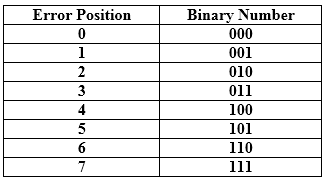
Let's understand the concept of Hamming code through an example:
Suppose the original data is 1010 which is to be sent.
Total number of data bits 'd' = 4
Number of redundant bits r : 2r >= d+r+1
2r>= 4+r+1
Therefore, the value of r is 3 that satisfies the above relation.
Total number of bits = d+r = 4+3 = 7;
Determining the position of the redundant bits
The number of redundant bits is 3. The three bits are represented by r1, r2, r4. The position of the redundant bits is calculated with corresponds to the raised power of 2. Therefore, their corresponding positions are 1, 21, 22.
- The position of r1 = 1
- The position of r2 = 2
- The position of r4 = 4
Representation of Data on the addition of parity bits:

Determining the Parity bits
Determining the r1 bit
The r1 bit is calculated by performing a parity check on the bit positions whose binary representation includes 1 in the first position.
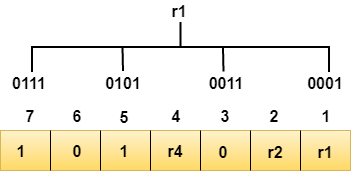
We observe from the above figure that the bit positions that includes 1 in the first position are 1, 3, 5, 7. Now, we perform the even-parity check at these bit positions. The total number of 1 at these bit positions corresponding to r1 is even, therefore, the value of the r1 bit is 0.
Determining r2 bit
The r2 bit is calculated by performing a parity check on the bit positions whose binary representation includes 1 in the second position.

We observe from the above figure that the bit positions that includes 1 in the second position are 2, 3, 6, 7. Now, we perform the even-parity check at these bit positions. The total number of 1 at these bit positions corresponding to r2 is odd, therefore, the value of the r2 bit is 1.
Determining r4 bit
The r4 bit is calculated by performing a parity check on the bit positions whose binary representation includes 1 in the third position.
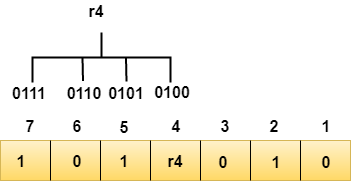
We observe from the above figure that the bit positions that includes 1 in the third position are 4, 5, 6, 7. Now, we perform the even-parity check at these bit positions. The total number of 1 at these bit positions corresponding to r4 is even, therefore, the value of the r4 bit is 0.
Data transferred is given below:

Suppose the 4th bit is changed from 0 to 1 at the receiving end, then parity bits are recalculated.
R1 bit
The bit positions of the r1 bit are 1,3,5,7
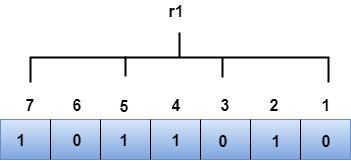
We observe from the above figure that the binary representation of r1 is 1100. Now, we perform the even-parity check, the total number of 1s appearing in the r1 bit is an even number. Therefore, the value of r1 is 0.
R2 bit
The bit positions of r2 bit are 2,3,6,7.
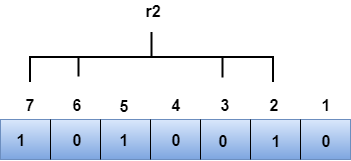
We observe from the above figure that the binary representation of r2 is 1001. Now, we perform the even-parity check, the total number of 1s appearing in the r2 bit is an even number. Therefore, the value of r2 is 0.
R4 bit
The bit positions of r4 bit are 4,5,6,7.

We observe from the above figure that the binary representation of r4 is 1011. Now, we perform the even-parity check, the total number of 1s appearing in the r4 bit is an odd number. Therefore, the value of r4 is 1.
- The binary representation of redundant bits, i.e., r4r2r1 is 100, and its corresponding decimal value is 4. Therefore, the error occurs in a 4th bit position. The bit value must be changed from 1 to 0 to correct the error.
Error Detection
When data is transmitted from one device to another device, the system does not guarantee whether the data received by the device is identical to the data transmitted by another device. An Error is a situation when the message received at the receiver end is not identical to the message transmitted.
Types Of Errors
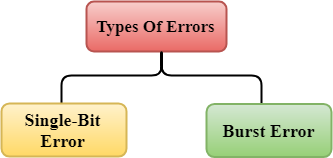
Fig 1 – Types of errors
Errors can be classified into two categories:
- Single-Bit Error
- Burst Error
Single-Bit Error:
The only one bit of a given data unit is changed from 1 to 0 or from 0 to 1.

Fig 2 – Single bit error
In the above figure, the message which is sent is corrupted as single-bit, i.e., 0 bit is changed to 1.
Single-Bit Error does not appear more likely in Serial Data Transmission. For example, Sender sends the data at 10 Mbps, this means that the bit lasts only for 1 ?s and for a single-bit error to occurred, a noise must be more than 1 ?s.
Single-Bit Error mainly occurs in Parallel Data Transmission. For example, if eight wires are used to send the eight bits of a byte, if one of the wire is noisy, then single-bit is corrupted per byte.
Burst Error:
The two or more bits are changed from 0 to 1 or from 1 to 0 is known as Burst Error.
The Burst Error is determined from the first corrupted bit to the last corrupted bit.
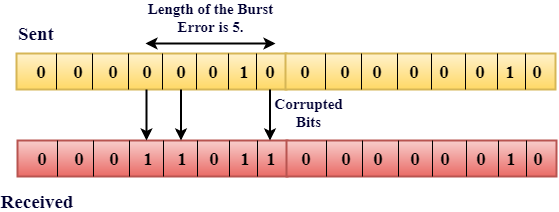
Fig 3 - Burst Error
The duration of noise in Burst Error is more than the duration of noise in Single-Bit.
Burst Errors are most likely to occurr in Serial Data Transmission.
The number of affected bits depends on the duration of the noise and data rate.
Error Detecting Techniques:
The most popular Error Detecting Techniques are:
- Single parity check
- Two-dimensional parity check
- Checksum
- Cyclic redundancy check
Single Parity Check
- Single Parity checking is the simple mechanism and inexpensive to detect the errors.
- In this technique, a redundant bit is also known as a parity bit which is appended at the end of the data unit so that the number of 1s becomes even. Therefore, the total number of transmitted bits would be 9 bits.
- If the number of 1s bits is odd, then parity bit 1 is appended and if the number of 1s bits is even, then parity bit 0 is appended at the end of the data unit.
- At the receiving end, the parity bit is calculated from the received data bits and compared with the received parity bit.
- This technique generates the total number of 1s even, so it is known as even-parity checking.
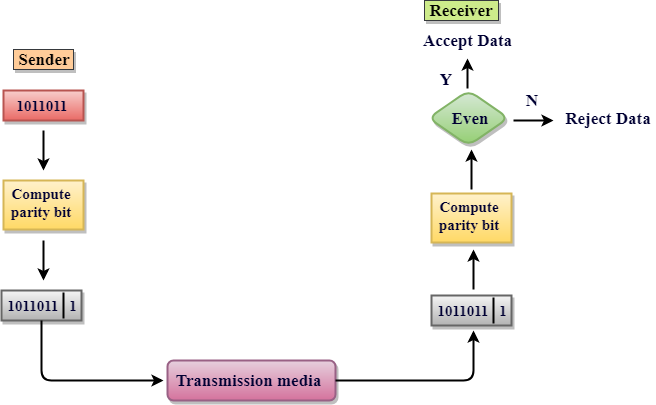
Fig 5 - Single Parity Check
Drawbacks Of Single Parity Checking
- It can only detect single-bit errors which are very rare.
- If two bits are interchanged, then it cannot detect the errors.
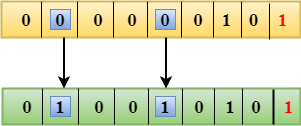
Two-Dimensional Parity Check
- Performance can be improved by using Two-Dimensional Parity Check which organizes the data in the form of a table.
- Parity check bits are computed for each row, which is equivalent to the single-parity check.
- In Two-Dimensional Parity check, a block of bits is divided into rows, and the redundant row of bits is added to the whole block.
- At the receiving end, the parity bits are compared with the parity bits computed from the received data.

Drawbacks Of 2D Parity Check
- If two bits in one data unit are corrupted and two bits exactly the same position in another data unit are also corrupted, then 2D Parity checker will not be able to detect the error.
- This technique cannot be used to detect the 4-bit errors or more in some cases.
Checksum
A Checksum is an error detection technique based on the concept of redundancy.
It is divided into two parts:
Checksum Generator
A Checksum is generated at the sending side. Checksum generator subdivides the data into equal segments of n bits each, and all these segments are added together by using one's complement arithmetic. The sum is complemented and appended to the original data, known as checksum field. The extended data is transmitted across the network.
Suppose L is the total sum of the data segments, then the checksum would be ?L
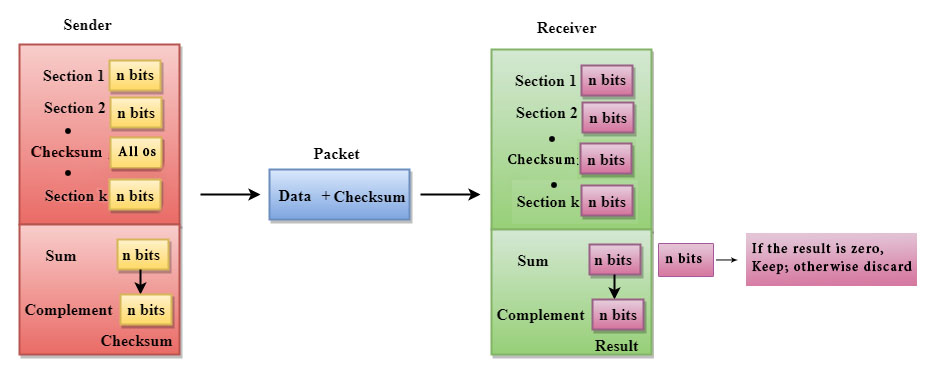
Fig 6 – Checksum
- The Sender follows the given steps:
- The block unit is divided into k sections, and each of n bits.
- All the k sections are added together by using one's complement to get the sum.
- The sum is complemented and it becomes the checksum field.
- The original data and checksum field are sent across the network.
Checksum Checker
A Checksum is verified at the receiving side. The receiver subdivides the incoming data into equal segments of n bits each, and all these segments are added together, and then this sum is complemented. If the complement of the sum is zero, then the data is accepted otherwise data is rejected.
- The Receiver follows the given steps:
- The block unit is divided into k sections and each of n bits.
- All the k sections are added together by using one's complement algorithm to get the sum.
- The sum is complemented.
- If the result of the sum is zero, then the data is accepted otherwise the data is discarded.
Cyclic Redundancy Check (CRC)
CRC is a redundancy error technique used to determine the error.
Following are the steps used in CRC for error detection:
- In CRC technique, a string of n 0s is appended to the data unit, and this n number is less than the number of bits in a predetermined number, known as division which is n+1 bits.
- Secondly, the newly extended data is divided by a divisor using a process is known as binary division. The remainder generated from this division is known as CRC remainder.
- Thirdly, the CRC remainder replaces the appended 0s at the end of the original data. This newly generated unit is sent to the receiver.
- The receiver receives the data followed by the CRC remainder. The receiver will treat this whole unit as a single unit, and it is divided by the same divisor that was used to find the CRC remainder.
If the resultant of this division is zero which means that it has no error, and the data is accepted.
If the resultant of this division is not zero which means that the data consists of an error. Therefore, the data is discarded.
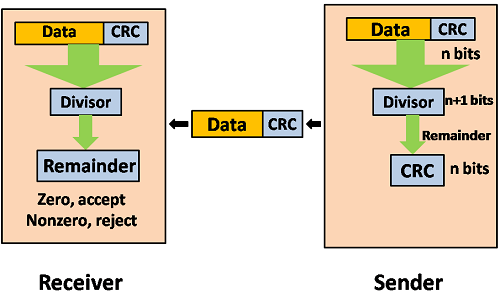
Fig 7 – Data CRC
Let's understand this concept through an example:
Suppose the original data is 11100 and divisor is 1001.
CRC Generator
- A CRC generator uses a modulo-2 division. Firstly, three zeroes are appended at the end of the data as the length of the divisor is 4 and we know that the length of the string 0s to be appended is always one less than the length of the divisor.
- Now, the string becomes 11100000, and the resultant string is divided by the divisor 1001.
- The remainder generated from the binary division is known as CRC remainder. The generated value of the CRC remainder is 111.
- CRC remainder replaces the appended string of 0s at the end of the data unit, and the final string would be 11100111 which is sent across the network.
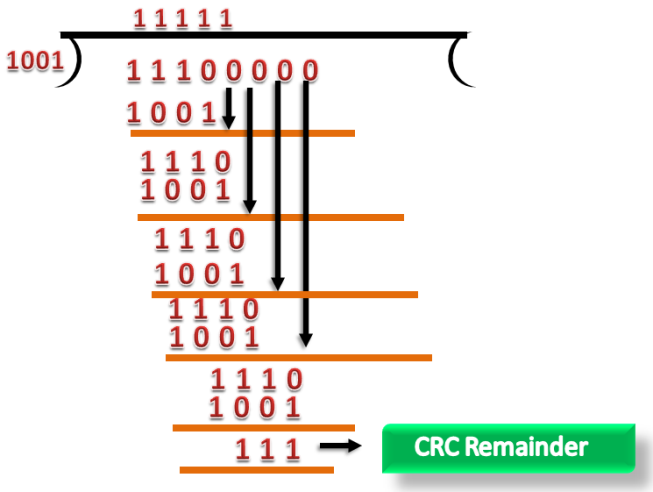
CRC Checker
- The functionality of the CRC checker is similar to the CRC generator.
- When the string 11100111 is received at the receiving end, then CRC checker performs the modulo-2 division.
- A string is divided by the same divisor, i.e., 1001.
- In this case, CRC checker generates the remainder of zero. Therefore, the data is accepted.
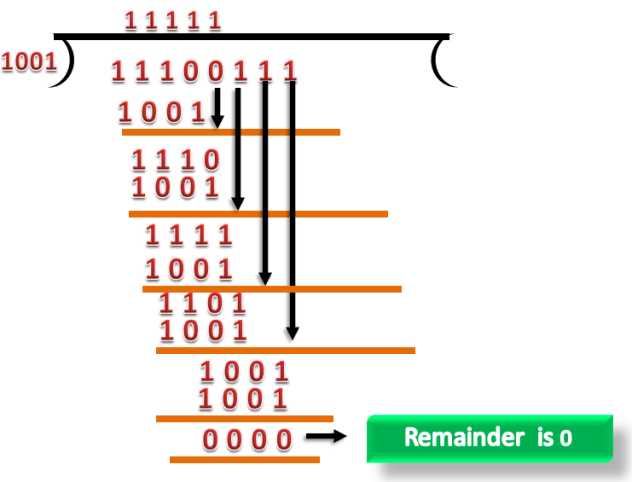
Error Control Coding
Noise or Error is the main problem in the signal, which disturbs the reliability of the communication system. Error control coding is the coding procedure done to control the occurrences of errors. These techniques help in Error Detection and Error Correction.
There are many different error correcting codes depending upon the mathematical principles applied to them. But, historically, these codes have been classified into Linear block codes and Convolution codes.
Linear Block Codes
In the linear block codes, the parity bits and message bits have a linear combination, which means that the resultant code word is the linear combination of any two code words.
Let us consider some blocks of data, which contains k bits in each block. These bits are mapped with the blocks which has n bits in each block. Here n is greater than k. The transmitter adds redundant bits which are n−k
Bits. The ratio k/n is the code rate. It is denoted by r and the value of r is r < 1.
The n−k
Bits added here, are parity bits. Parity bits help in error detection and error correction, and also in locating the data. In the data being transmitted, the left most bits of the code word correspond to the message bits, and the right most bits of the code word correspond to the parity bits.
Systematic Code
Any linear block code can be a systematic code, until it is altered. Hence, an unaltered block code is called as a systematic code.
Following is the representation of the structure of code word, according to their allocation.

Fig 8 – Structure of code word
If the message is not altered, then it is called as systematic code. It means, the encryption of the data should not change the data.
Convolution Codes
So far, in the linear codes, we have discussed that systematic unaltered code is preferred. Here, the data of total n bits if transmitted, k bits are message bits and n−k
Bits are parity bits.
In the process of encoding, the parity bits are subtracted from the whole data and the message bits are encoded. Now, the parity bits are again added and the whole data is again encoded.
The following figure quotes an example for blocks of data and stream of data, used for transmission of information.
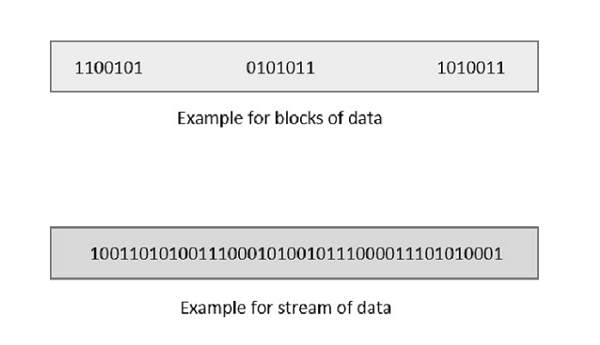
The whole process, stated above is tedious which has drawbacks. The allotment of buffer is a main problem here, when the system is busy.
This drawback is cleared in convolution codes. Where the whole stream of data is assigned symbols and then transmitted. As the data is a stream of bits, there is no need of buffer for storage.
Hamming Codes
The linearity property of the code word is that the sum of two code words is also a code word. Hamming codes are the type of linear error correcting codes, which can detect up to two bit errors or they can correct one bit errors without the detection of uncorrected errors.
While using the hamming codes, extra parity bits are used to identify a single bit error. To get from one-bit pattern to the other, few bits are to be changed in the data. Such number of bits can be termed as Hamming distance. If the parity has a distance of 2, one-bit flip can be detected. But this can't be corrected. Also, any two bit flips cannot be detected.
However, Hamming code is a better procedure than the previously discussed ones in error detection and correction.
BCH Codes
BCH codes are named after the inventors Bose, Chaudari and Hocquenghem. During the BCH code design, there is control on the number of symbols to be corrected and hence multiple bit correction is possible. BCH codes is a powerful technique in error correcting codes.
For any positive integers m ≥ 3 and t < 2m-1 there exists a BCH binary code. Following are the parameters of such code.
Block length n = 2m-1
Number of parity-check digits n - k ≤ mt
Minimum distance dmin ≥ 2t + 1
This code can be called as t-error-correcting BCH code.
Cyclic Codes
The cyclic property of code words is that any cyclic-shift of a code word is also a code word. Cyclic codes follow this cyclic property.
For a linear code C, if every code word i.e., C = C1,C2,......Cn
From C has a cyclic right shift of components, it becomes a code word. This shift of right is equal to n-1 cyclic left shifts. Hence, it is invariant under any shift. So, the linear code C, as it is invariant under any shift, can be called as a Cyclic code.
Cyclic codes are used for error correction. They are mainly used to correct double errors and burst errors.
Hence, these are a few error correcting codes, which are to be detected at the receiver. These codes prevent the errors from getting introduced and disturb the communication. They also prevent the signal from getting tapped by unwanted receivers.
Key takeaways
- Error Correction codes are used to detect and correct the errors when data is transmitted from the sender to the receiver.
- Error Correction can be handled in two ways:
- Backward error correction: Once the error is discovered, the receiver requests the sender to retransmit the entire data unit.
- Forward error correction: In this case, the receiver uses the error-correcting code which automatically corrects the errors.
3. A single additional bit can detect the error, but cannot correct it.
4. For correcting the errors, one has to know the exact position of the error. For example, If we want to calculate a single-bit error, the error correction code will determine which one of seven bits is in error. To achieve this, we have to add some additional redundant bits.
5. Suppose r is the number of redundant bits and d is the total number of the data bits. The number of redundant bits r can be calculated by using the formula:
2r>=d+r+1
6. The value of r is calculated by using the above formula. For example, if the value of d is 4, then the possible smallest value that satisfies the above relation would be 3.
7. To determine the position of the bit which is in error, a technique developed by R.W Hamming is Hamming code which can be applied to any length of the data unit and uses the relationship between data units and redundant units.
Stop and Wait Protocol
Before understanding the stop and Wait protocol, we first know about the error control mechanism. The error control mechanism is used so that the received data should be exactly same whatever sender has sent the data. The error control mechanism is divided into two categories, i.e., Stop and Wait ARQ and sliding window. The sliding window is further divided into two categories, i.e., Go Back N, and Selective Repeat. Based on the usage, the people select the error control mechanism whether it is stop and wait or sliding window.
What is Stop and Wait protocol?
Here stop and wait means, whatever the data that sender wants to send, he sends the data to the receiver. After sending the data, he stops and waits until he receives the acknowledgment from the receiver. The stop and wait protocol is a flow control protocol where flow control is one of the services of the data link layer.
It is a data-link layer protocol which is used for transmitting the data over the noiseless channels. It provides unidirectional data transmission which means that either sending or receiving of data will take place at a time. It provides flow-control mechanism but does not provide any error control mechanism.
The idea behind the usage of this frame is that when the sender sends the frame then he waits for the acknowledgment before sending the next frame.
Primitives of Stop and Wait Protocol
The primitives of stop and wait protocol are:
Sender side
Rule 1: Sender sends one data packet at a time.
Rule 2: Sender sends the next packet only when it receives the acknowledgment of the previous packet.
Therefore, the idea of stop and wait protocol in the sender's side is very simple, i.e., send one packet at a time, and do not send another packet before receiving the acknowledgment.
Receiver side
Rule 1: Receive and then consume the data packet.
Rule 2: When the data packet is consumed, receiver sends the acknowledgment to the sender.
Therefore, the idea of stop and wait protocol in the receiver's side is also very simple, i.e., consume the packet, and once the packet is consumed, the acknowledgment is sent. This is known as a flow control mechanism.
Working of Stop and Wait protocol

Fig 9 - Working of Stop and Wait protocol
The above figure shows the working of the stop and wait protocol. If there is a sender and receiver, then sender sends the packet and that packet is known as a data packet. The sender will not send the second packet without receiving the acknowledgment of the first packet. The receiver sends the acknowledgment for the data packet that it has received. Once the acknowledgment is received, the sender sends the next packet. This process continues until all the packet are not sent. The main advantage of this protocol is its simplicity but it has some disadvantages also. For example, if there are 1000 data packets to be sent, then all the 1000 packets cannot be sent at a time as in Stop and Wait protocol, one packet is sent at a time.
Disadvantages of Stop and Wait protocol
The following are the problems associated with a stop and wait protocol:
1. Problems occur due to lost data
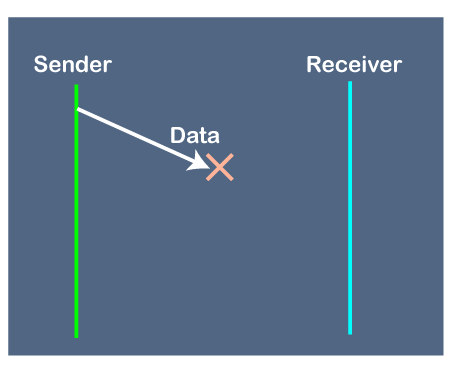
Fig 10 - Problems occur due to lost data
Suppose the sender sends the data and the data is lost. The receiver is waiting for the data for a long time. Since the data is not received by the receiver, so it does not send any acknowledgment. Since the sender does not receive any acknowledgment so it will not send the next packet. This problem occurs due to the lost data.
In this case, two problems occur:
- Sender waits for an infinite amount of time for an acknowledgment.
- Receiver waits for an infinite amount of time for a data.
2. Problems occur due to lost acknowledgment
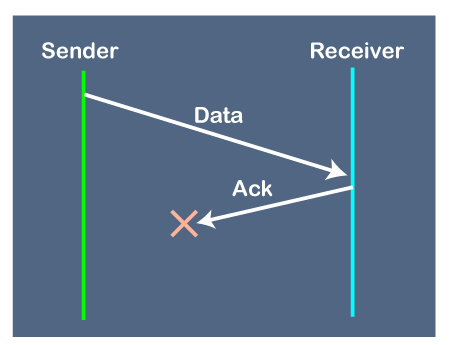
Suppose the sender sends the data and it has also been received by the receiver. On receiving the packet, the receiver sends the acknowledgment. In this case, the acknowledgment is lost in a network, so there is no chance for the sender to receive the acknowledgment. There is also no chance for the sender to send the next packet as in stop and wait protocol, the next packet cannot be sent until the acknowledgment of the previous packet is received.
In this case, one problem occurs:
- Sender waits for an infinite amount of time for an acknowledgment.
3. Problem due to the delayed data or acknowledgment
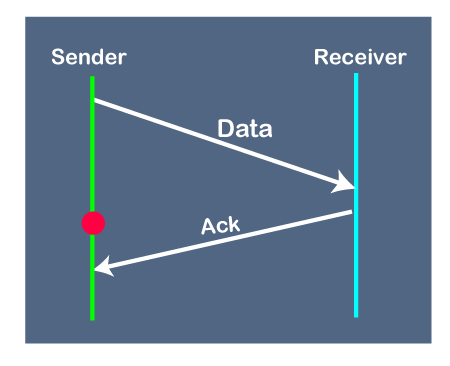
Suppose the sender sends the data and it has also been received by the receiver. The receiver then sends the acknowledgment but the acknowledgment is received after the timeout period on the sender's side. As the acknowledgment is received late, so acknowledgment can be wrongly considered as the acknowledgment of some other data packet.
Go-Back-N ARQ
Before understanding the working of Go-Back-N ARQ, we first look at the sliding window protocol. As we know that the sliding window protocol is different from the stop-and-wait protocol. In the stop-and-wait protocol, the sender can send only one frame at a time and cannot send the next frame without receiving the acknowledgment of the previously sent frame, whereas, in the case of sliding window protocol, the multiple frames can be sent at a time. The variations of sliding window protocol are Go-Back-N ARQ and Selective Repeat ARQ. Let's understand 'what is Go-Back-N ARQ'.
What is Go-Back-N ARQ?
In Go-Back-N ARQ, N is the sender's window size. Suppose we say that Go-Back-3, which means that the three frames can be sent at a time before expecting the acknowledgment from the receiver.
It uses the principle of protocol pipelining in which the multiple frames can be sent before receiving the acknowledgment of the first frame. If we have five frames and the concept is Go-Back-3, which means that the three frames can be sent, i.e., frame no 1, frame no 2, frame no 3 can be sent before expecting the acknowledgment of frame no 1.
In Go-Back-N ARQ, the frames are numbered sequentially as Go-Back-N ARQ sends the multiple frames at a time that requires the numbering approach to distinguish the frame from another frame, and these numbers are known as the sequential numbers.
The number of frames that can be sent at a time totally depends on the size of the sender's window. So, we can say that 'N' is the number of frames that can be sent at a time before receiving the acknowledgment from the receiver.
If the acknowledgment of a frame is not received within an agreed-upon time period, then all the frames available in the current window will be retransmitted. Suppose we have sent the frame no 5, but we didn't receive the acknowledgment of frame no 5, and the current window is holding three frames, then these three frames will be retransmitted.
The sequence number of the outbound frames depends upon the size of the sender's window. Suppose the sender's window size is 2, and we have ten frames to send, then the sequence numbers will not be 1,2,3,4,5,6,7,8,9,10. Let's understand through an example.
- N is the sender's window size.
- If the size of the sender's window is 4 then the sequence number will be 0,1,2,3,0,1,2,3,0,1,2, and so on.
The number of bits in the sequence number is 2 to generate the binary sequence 00,01,10,11.
Working of Go-Back-N ARQ
Suppose there are a sender and a receiver, and let's assume that there are 11 frames to be sent. These frames are represented as 0,1,2,3,4,5,6,7,8,9,10, and these are the sequence numbers of the frames. Mainly, the sequence number is decided by the sender's window size. But, for the better understanding, we took the running sequence numbers, i.e., 0,1,2,3,4,5,6,7,8,9,10. Let's consider the window size as 4, which means that the four frames can be sent at a time before expecting the acknowledgment of the first frame.
Step 1: Firstly, the sender will send the first four frames to the receiver, i.e., 0,1,2,3, and now the sender is expected to receive the acknowledgment of the 0th frame.
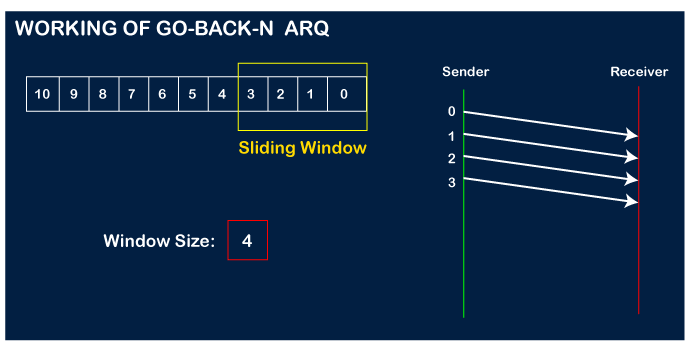
Let's assume that the receiver has sent the acknowledgment for the 0 frame, and the receiver has successfully received it.

The sender will then send the next frame, i.e., 4, and the window slides containing four frames (1,2,3,4).
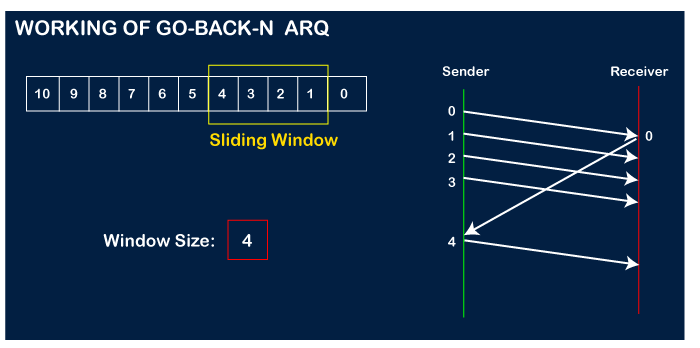
The receiver will then send the acknowledgment for the frame no 1. After receiving the acknowledgment, the sender will send the next frame, i.e., frame no 5, and the window will slide having four frames (2,3,4,5).

Now, let's assume that the receiver is not acknowledging the frame no 2, either the frame is lost, or the acknowledgment is lost. Instead of sending the frame no 6, the sender Go-Back to 2, which is the first frame of the current window, retransmits all the frames in the current window, i.e., 2,3,4,5.
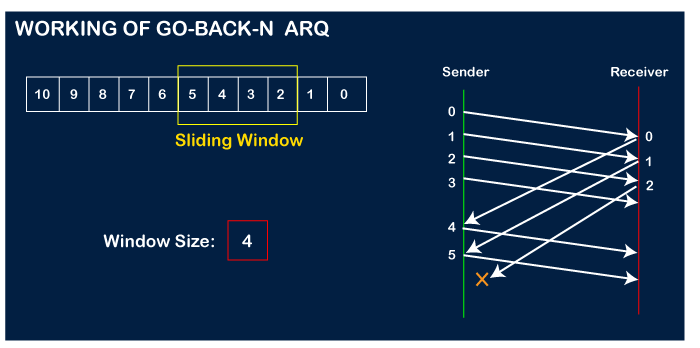
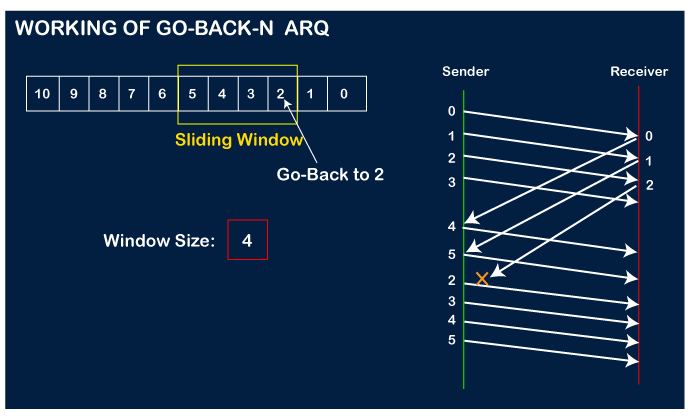
Important points related to Go-Back-N ARQ:
- In Go-Back-N, N determines the sender's window size, and the size of the receiver's window is always 1.
- It does not consider the corrupted frames and simply discards them.
- It does not accept the frames which are out of order and discards them.
- If the sender does not receive the acknowledgment, it leads to the retransmission of all the current window frames.
Let's understand the Go-Back-N ARQ through an example.
Example 1: In GB4, if every 6th packet being transmitted is lost and if we have to spend 10 packets then how many transmissions are required?
Solution: Here, GB4 means that N is equal to 4. The size of the sender's window is 4.
Step 1: As the window size is 4, so four packets are transferred at a time, i.e., packet no 1, packet no 2, packet no 3, and packet no 4.

Step 2: Once the transfer of window size is completed, the sender receives the acknowledgment of the first frame, i.e., packet no1. As the acknowledgment receives, the sender sends the next packet, i.e., packet no 5. In this case, the window slides having four packets, i.e., 2,3,4,5 and excluded the packet 1 as the acknowledgment of the packet 1 has been received successfully.

Step 3: Now, the sender receives the acknowledgment of packet 2. After receiving the acknowledgment for packet 2, the sender sends the next packet, i.e., packet no 6. As mentioned in the question that every 6th is being lost, so this 6th packet is lost, but the sender does not know that the 6th packet has been lost.
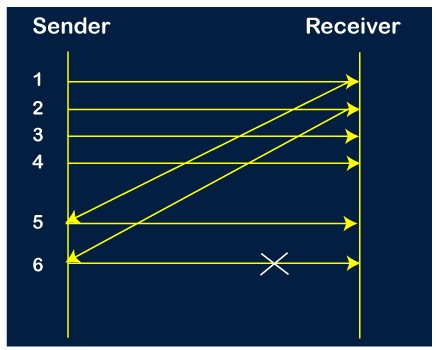
Step 4: The sender receives the acknowledgment for the packet no 3. After receiving the acknowledgment of 3rd packet, the sender sends the next packet, i.e., 7th packet. The window will slide having four packets, i.e., 4, 5, 6, 7.
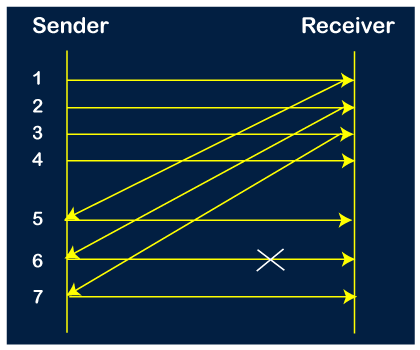
Step 5: When the packet 7 has been sent, then the sender receives the acknowledgment for the packet no 4. When the sender has received the acknowledgment, then the sender sends the next packet, i.e., the 8th packet. The window will slide having four packets, i.e., 5, 6, 7, 8.
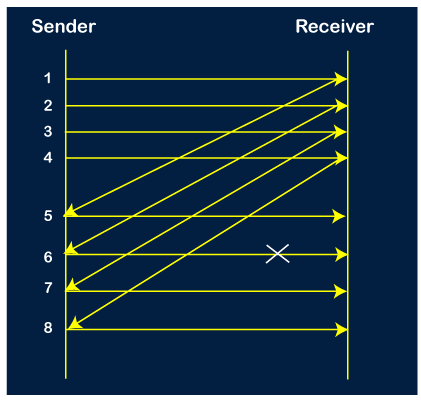
Step 6: When the packet 8 is sent, then the sender receives the acknowledgment of packet 5. On receiving the acknowledgment of packet 5, the sender sends the next packet, i.e., 9th packet. The window will slide having four packets, i.e., 6, 7, 8, 9.
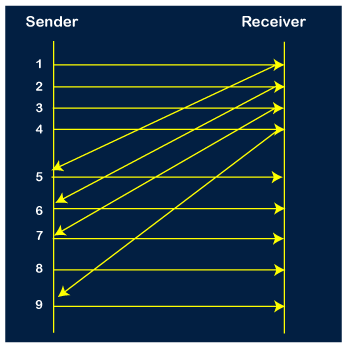
Step 7: The current window is holding four packets, i.e., 6, 7, 8, 9, where the 6th packet is the first packet in the window. As we know, the 6th packet has been lost, so the sender receives the negative acknowledgment NAK(6). As we know that every 6th packet is being lost, so the counter will be restarted from 1. So, the counter values 1, 2, 3 are given to the 7th packet, 8th packet, 9th packet respectively.

Step 8: As it is Go-BACK, so it retransmits all the packets of the current window. It will resend 6, 7, 8, 9. The counter values of 6, 7, 8, 9 are 4, 5, 6, 1, respectively. In this case, the 8th packet is lost as it has a 6-counter value, so the counter variable will again be restarted from 1.
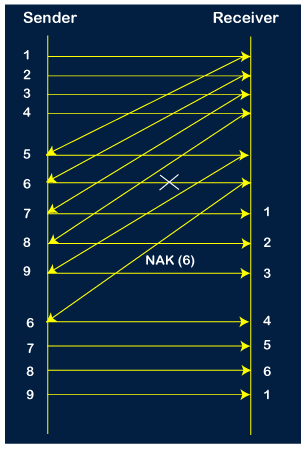
Step 9: After the retransmission, the sender receives the acknowledgment of packet 6. On receiving the acknowledgment of packet 6, the sender sends the 10th packet. Now, the current window is holding four packets, i.e., 7, 8, 9, 10.
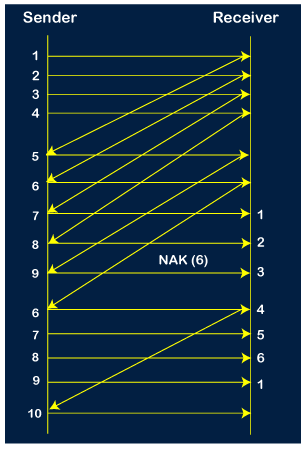
Step 10: When the 10th packet is sent, the sender receives the acknowledgment of packet 7. Now the current window is holding three packets, 8, 9 and 10. The counter values of 8, 9, 10 are 6, 1, 2.
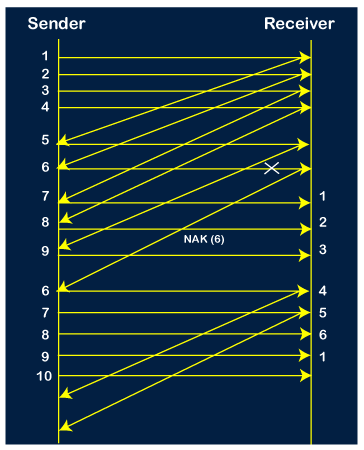
Step 11: As the 8th packet has 6 counter value which means that 8th packet has been lost, and the sender receives NAK (8).
Step 12: Since the sender has received the negative acknowledgment for the 8th packet, it resends all the packets of the current window, i.e., 8, 9, 10.
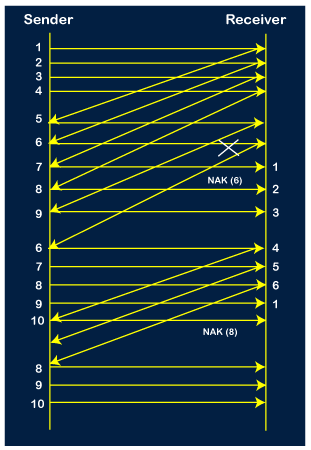
Step 13: The counter values of 8, 9, 10 are 3, 4, 5, respectively, so their acknowledgments have been received successfully.
We conclude from the above figure that total 17 transmissions are required.
A Protocol Using Selective Repeat
Selective repeat protocol, also called Selective Repeat ARQ (Automatic Repeat reQuest), is a data link layer protocol that uses sliding window method for reliable delivery of data frames. Here, only the erroneous or lost frames are retransmitted, while the good frames are received and buffered.
It uses two windows of equal size: a sending window that stores the frames to be sent and a receiving window that stores the frames receive by the receiver. The size is half the maximum sequence number of the frame. For example, if the sequence number is from 0 – 15, the window size will be 8.
Working Principle
Selective Repeat protocol provides for sending multiple frames depending upon the availability of frames in the sending window, even if it does not receive acknowledgement for any frame in the interim. The maximum number of frames that can be sent depends upon the size of the sending window.
The receiver records the sequence number of the earliest incorrect or un-received frame. It then fills the receiving window with the subsequent frames that it has received. It sends the sequence number of the missing frame along with every acknowledgement frame.
The sender continues to send frames that are in its sending window. Once, it has sent all the frames in the window, it retransmits the frame whose sequence number is given by the acknowledgements. It then continues sending the other frames.
Sender Site Algorithm of Selective Repeat Protocol
Begin
Frame s; //s denotes frame to be sent
Frame t; //t is temporary frame
S_window = power(2,m-1); //Assign maximum window size
SeqFirst = 0; // Sequence number of first frame in window
SeqN = 0; // Sequence number of Nth frame window
While (true) //check repeatedly
Do
Wait_For_Event(); //wait for availability of packet
If ( Event(Request_For_Transfer)) then
//check if window is full
If (SeqN–SeqFirst >= S_window) then
DoNothing();
End if;
Get_Data_From_Network_Layer();
s = Make_Frame();
s.seq = SeqN;
Store_Copy_Frame(s);
Send_Frame(s);
Start_Timer(s);
SeqN = SeqN + 1;
End if;
If ( Event(Frame_Arrival) then
r = Receive_Acknowledgement();
//Resend frame whose sequence number is with ACK
If ( r.type = NAK) then
If ( NAK_No > SeqFirst && NAK_No < SeqN ) then
Retransmit( s.seq(NAK_No));
Start_Timer(s);
End if
//Remove frames from sending window with positive ACK
Else if ( r.type = ACK ) then
Remove_Frame(s.seq(SeqFirst));
Stop_Timer(s);
SeqFirst = SeqFirst + 1;
End if
End if
// Resend frame if acknowledgement haven’t been received
If ( Event(Time_Out)) then
Start_Timer(s);
Retransmit_Frame(s);
End if
End
Receiver Site Algorithm of Selective Repeat Protocol
Begin
Frame f;
RSeqNo = 0; // Initialise sequence number of expected frame
NAKsent = false;
ACK = false;
For each slot in receive_window
Mark(slot)=false;
While (true) //check repeatedly
Do
Wait_For_Event(); //wait for arrival of frame
If ( Event(Frame_Arrival) then
Receive_Frame_From_Physical_Layer();
If ( Corrupted ( f.SeqNo ) AND NAKsent = false) then
SendNAK(f.SeqNo);
NAKsent = true;
End if
If ( f.SeqNo != RSeqNo AND NAKsent = false ) then
SendNAK(f.SeqNo);
NAKsent = true;
If ( f.SeqNo is in receive_window ) then
If ( Mark(RSeqNo) = false ) then
Store_frame(f.SeqNo);
Mark(RSeqNo) = true;
End if
End if
Else
While ( Mark(RSeqNo))
Extract_Data(RSeqNo);
Deliver_Data_To_Network_Layer();
RSeqNo = RSeqNo + 1;
Send_ACK(RSeqNo);
End while
End if
End if
End while
End
Sliding Window Protocol
The sliding window is a technique for sending multiple frames at a time. It controls the data packets between the two devices where reliable and gradual delivery of data frames is needed. It is also used in TCP (Transmission Control Protocol).
In this technique, each frame has sent from the sequence number. The sequence numbers are used to find the missing data in the receiver end. The purpose of the sliding window technique is to avoid duplicate data, so it uses the sequence number.
Types of Sliding Window Protocol
Sliding window protocol has two types:
- Go-Back-N ARQ
- Selective Repeat ARQ
Go-Back-N ARQ
Go-Back-N ARQ protocol is also known as Go-Back-N Automatic Repeat Request. It is a data link layer protocol that uses a sliding window method. In this, if any frame is corrupted or lost, all subsequent frames have to be sent again.
The size of the sender window is N in this protocol. For example, Go-Back-8, the size of the sender window, will be 8. The receiver window size is always 1.
If the receiver receives a corrupted frame, it cancels it. The receiver does not accept a corrupted frame. When the timer expires, the sender sends the correct frame again. The design of the Go-Back-N ARQ protocol is shown below.

The example of Go-Back-N ARQ is shown below in the figure.
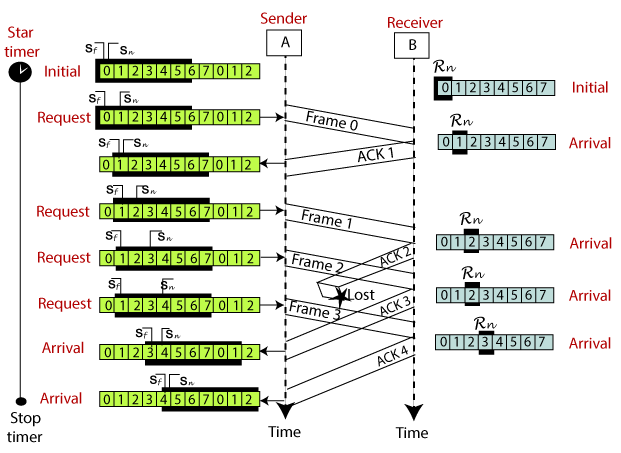
Selective Repeat ARQ
Selective Repeat ARQ is also known as the Selective Repeat Automatic Repeat Request. It is a data link layer protocol that uses a sliding window method. The Go-back-N ARQ protocol works well if it has fewer errors. But if there is a lot of error in the frame, lots of bandwidth loss in sending the frames again. So, we use the Selective Repeat ARQ protocol. In this protocol, the size of the sender window is always equal to the size of the receiver window. The size of the sliding window is always greater than 1.
If the receiver receives a corrupt frame, it does not directly discard it. It sends a negative acknowledgment to the sender. The sender sends that frame again as soon as on the receiving negative acknowledgment. There is no waiting for any time-out to send that frame. The design of the Selective Repeat ARQ protocol is shown below.
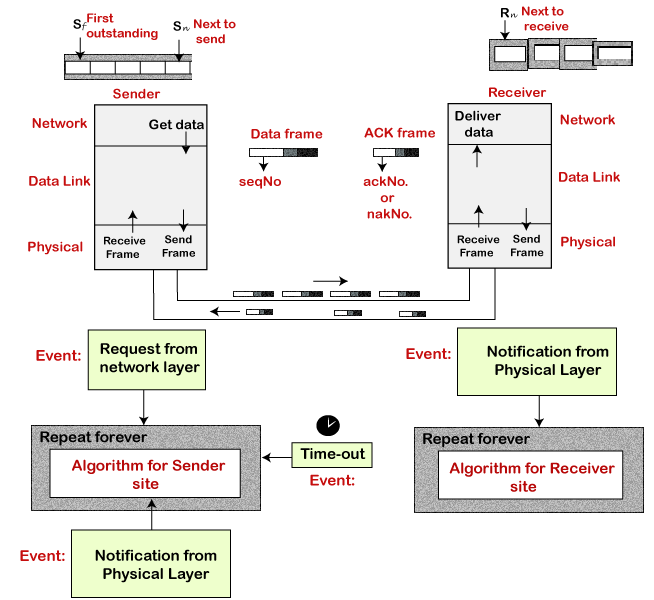
The example of the Selective Repeat ARQ protocol is shown below in the figure.
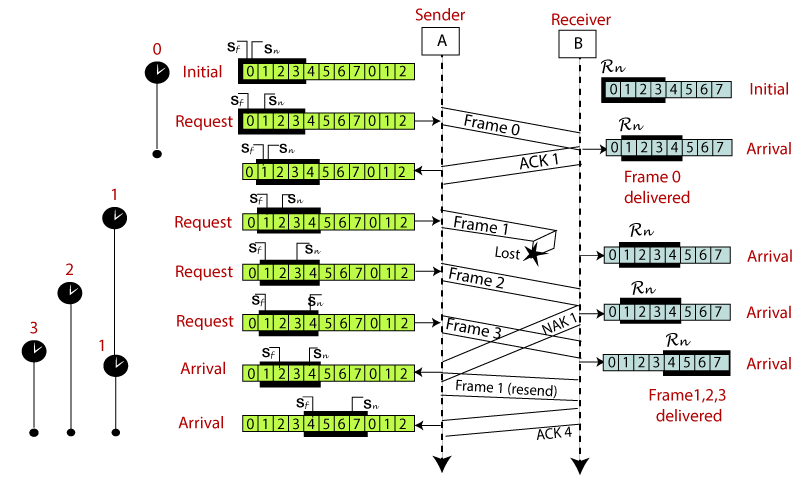
Difference between the Go-Back-N ARQ and Selective Repeat ARQ?
Go-Back-N ARQ | Selective Repeat ARQ |
If a frame is corrupted or lost in it,all subsequent frames have to be sent again. | In this, only the frame is sent again, which is corrupted or lost. |
If it has a high error rate,it wastes a lot of bandwidth. | There is a loss of low bandwidth. |
It is less complex. | It is more complex because it has to do sorting and searching as well. And it also requires more storage. |
It does not require sorting. | In this, sorting is done to get the frames in the correct order. |
It does not require searching. | The search operation is performed in it. |
It is used more. | It is used less because it is more complex. |
Why Piggybacking?
Communications are mostly full – duplex in nature, i.e. data transmission occurs in both directions. A method to achieve full – duplex communication is to consider both the communication as a pair of simplex communication. Each link comprises a forward channel for sending data and a reverse channel for sending acknowledgments.
However, in the above arrangement, traffic load doubles for each data unit that is transmitted. Half of all data transmission comprise of transmission of acknowledgments.
So, a solution that provides better utilization of bandwidth is piggybacking. Here, sending of acknowledgment is delayed until the next data frame is available for transmission. The acknowledgment is then hooked onto the outgoing data frame. The data frame consists of an ack field. The size of the ack field is only a few bits, while an acknowledgment frame comprises of several bytes. Thus, a substantial gain is obtained in reducing bandwidth requirement.
Working Principle
Suppose that there are two communication stations X and Y. The data frames transmitted have an acknowledgment field, ack field that is of a few bits length. Additionally, there are frames for sending acknowledgments, ACK frames. The purpose is to minimize the ACK frames.
The three principles governing piggybacking when the station X wants to communicate with station Y are −
- If station X has both data and acknowledgment to send, it sends a data frame with the ack field containing the sequence number of the frame to be acknowledged.
- If station X has only an acknowledgment to send, it waits for a finite period of time to see whether a data frame is available to be sent. If a data frame becomes available, then it piggybacks the acknowledgment with it. Otherwise, it sends an ACK frame.
- If station X has only a data frame to send, it adds the last acknowledgment with it. The station Y discards all duplicate acknowledgments. Alternatively, station X may send the data frame with the ack field containing a bit combination denoting no acknowledgment.
Example
The following diagram illustrates the three scenario −
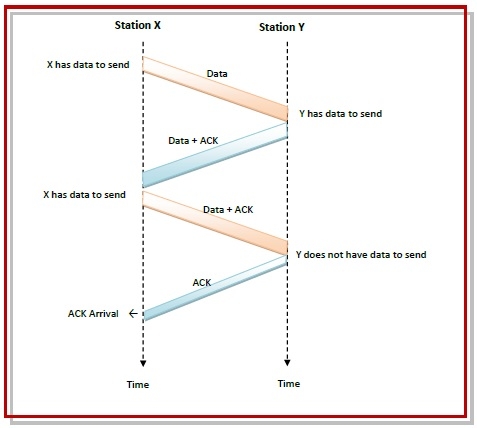
Multiple Access Protocols in Computer Networks
Multiple access protocols are a set of protocols operating in the Medium Access Control sublayer (MAC sublayer) of the Open Systems Interconnection (OSI) model. These protocols allow a number of nodes or users to access a shared network channel. Several data streams originating from several nodes are transferred through the multi-point transmission channel.
The objectives of multiple access protocols are optimization of transmission time, minimization of collisions and avoidance of crosstalks.
Categories of Multiple Access Protocols
Multiple access protocols can be broadly classified into three categories - random access protocols, controlled access protocols and channelization protocols.
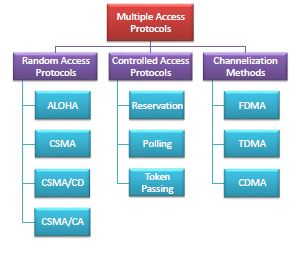
Fig 11 – Multiple Access Protocols
Random Access Protocols
Random access protocols assign uniform priority to all connected nodes. Any node can send data if the transmission channel is idle. No fixed time or fixed sequence is given for data transmission.
The four random access protocols are−
- ALOHA
- Carrier sense multiple access (CMSA)
- Carrier sense multiple access with collision detection (CMSA/CD)
- Carrier sense multiple access with collision avoidance (CMSA/CA)
Controlled Access Protocols
Controlled access protocols allow only one node to send data at a given time.Before initiating transmission, a node seeks information from other nodes to determine which station has the right to send. This avoids collision of messages on the shared channel.
The station can be assigned the right to send by the following three methods−
- Reservation
- Polling
- Token Passing
Channelization
Channelization are a set of methods by which the available bandwidth is divided among the different nodes for simultaneous data transfer.
The three channelization methods are−
- Frequency division multiple access (FDMA)
- Time division multiple access (TDMA)
- Code division multiple access (CDMA)
Key takeaways
- Before understanding the stop and Wait protocol, we first know about the error control mechanism. The error control mechanism is used so that the received data should be exactly same whatever sender has sent the data. The error control mechanism is divided into two categories, i.e., Stop and Wait ARQ and sliding window. The sliding window is further divided into two categories, i.e., Go Back N, and Selective Repeat. Based on the usage, the people select the error control mechanism whether it is stop and wait or sliding window.
Data Link Layer
The data link layer is used in a computer network to transmit the data between two devices or nodes. It divides the layer into parts such as data link control and the multiple access resolution/protocol. The upper layer has the responsibility to flow control and the error control in the data link layer, and hence it is termed as logical of data link control. Whereas the lower sub-layer is used to handle and reduce the collision or multiple access on a channel. Hence it is termed as media access control or the multiple access resolutions.
Data Link Control
A data link control is a reliable channel for transmitting data over a dedicated link using various techniques such as framing, error control and flow control of data packets in the computer network.
What is a multiple access protocol?
When a sender and receiver have a dedicated link to transmit data packets, the data link control is enough to handle the channel. Suppose there is no dedicated path to communicate or transfer the data between two devices. In that case, multiple stations access the channel and simultaneously transmits the data over the channel. It may create collision and cross talk. Hence, the multiple access protocol is required to reduce the collision and avoid crosstalk between the channels.
For example, suppose that there is a classroom full of students. When a teacher asks a question, all the students (small channels) in the class start answering the question at the same time (transferring the data simultaneously). All the students respond at the same time due to which data is overlap or data lost. Therefore it is the responsibility of a teacher (multiple access protocol) to manage the students and make them one answer.
Following are the types of multiple access protocol that is subdivided into the different process as:
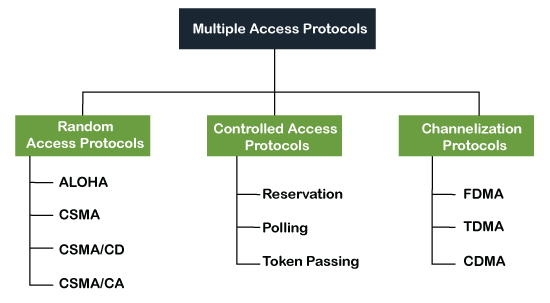
Fig 12 - Types of multiple access protocol
A. Random Access Protocol
In this protocol, all the station has the equal priority to send the data over a channel. In random access protocol, one or more stations cannot depend on another station nor any station control another station. Depending on the channel's state (idle or busy), each station transmits the data frame. However, if more than one station sends the data over a channel, there may be a collision or data conflict. Due to the collision, the data frame packets may be lost or changed. And hence, it does not receive by the receiver end.
Following are the different methods of random-access protocols for broadcasting frames on the channel.
- Aloha
- CSMA
- CSMA/CD
- CSMA/CA
ALOHA Random Access Protocol
It is designed for wireless LAN (Local Area Network) but can also be used in a shared medium to transmit data. Using this method, any station can transmit data across a network simultaneously when a data frameset is available for transmission.
Aloha Rules
- Any station can transmit data to a channel at any time.
- It does not require any carrier sensing.
- Collision and data frames may be lost during the transmission of data through multiple stations.
- Acknowledgment of the frames exists in Aloha. Hence, there is no collision detection.
- It requires retransmission of data after some random amount of time.

Fig 13 – Types of ALOHA
Pure Aloha
Whenever data is available for sending over a channel at stations, we use Pure Aloha. In pure Aloha, when each station transmits data to a channel without checking whether the channel is idle or not, the chances of collision may occur, and the data frame can be lost. When any station transmits the data frame to a channel, the pure Aloha waits for the receiver's acknowledgment. If it does not acknowledge the receiver end within the specified time, the station waits for a random amount of time, called the backoff time (Tb). And the station may assume the frame has been lost or destroyed. Therefore, it retransmits the frame until all the data are successfully transmitted to the receiver.
- The total vulnerable time of pure Aloha is 2 * Tfr.
- Maximum throughput occurs when G = 1/ 2 that is 18.4%.
- Successful transmission of data frame is S = G * e ^ - 2 G.
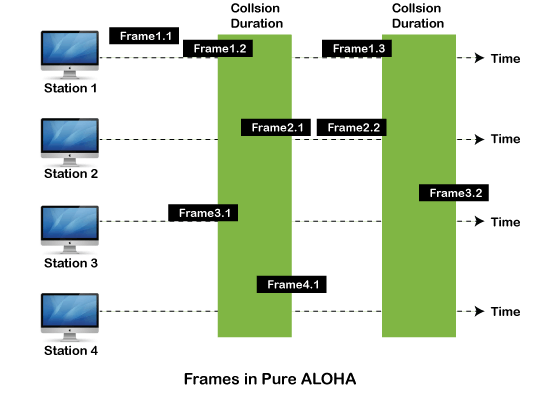
As we can see in the figure above, there are four stations for accessing a shared channel and transmitting data frames. Some frames collide because most stations send their frames at the same time. Only two frames, frame 1.1 and frame 2.2, are successfully transmitted to the receiver end. At the same time, other frames are lost or destroyed. Whenever two frames fall on a shared channel simultaneously, collisions can occur, and both will suffer damage. If the new frame's first bit enters the channel before finishing the last bit of the second frame. Both frames are completely finished, and both stations must retransmit the data frame.
Slotted Aloha
The slotted Aloha is designed to overcome the pure Aloha's efficiency because pure Aloha has a very high possibility of frame hitting. In slotted Aloha, the shared channel is divided into a fixed time interval called slots. So that, if a station wants to send a frame to a shared channel, the frame can only be sent at the beginning of the slot, and only one frame is allowed to be sent to each slot. And if the stations are unable to send data to the beginning of the slot, the station will have to wait until the beginning of the slot for the next time. However, the possibility of a collision remains when trying to send a frame at the beginning of two or more station time slot.
- Maximum throughput occurs in the slotted Aloha when G = 1 that is 37%.
- The probability of successfully transmitting the data frame in the slotted Aloha is S = G * e ^ - 2 G.
- The total vulnerable time required in slotted Aloha is Tfr.
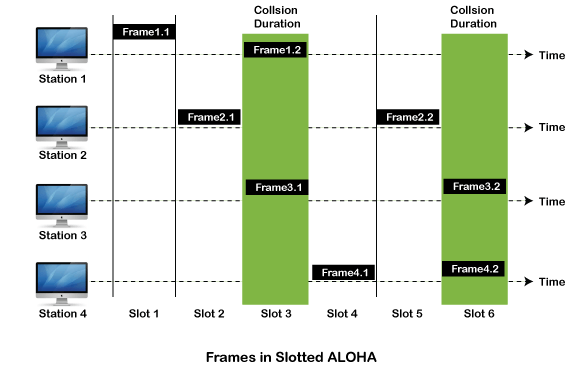
CSMA (Carrier Sense Multiple Access)
It is a carrier sense multiple access based on media access protocol to sense the traffic on a channel (idle or busy) before transmitting the data. It means that if the channel is idle, the station can send data to the channel. Otherwise, it must wait until the channel becomes idle. Hence, it reduces the chances of a collision on a transmission medium.
CSMA Access Modes
1-Persistent: In the 1-Persistent mode of CSMA that defines each node, first sense the shared channel and if the channel is idle, it immediately sends the data. Else it must wait and keep track of the status of the channel to be idle and broadcast the frame unconditionally as soon as the channel is idle.
Non-Persistent: It is the access mode of CSMA that defines before transmitting the data, each node must sense the channel, and if the channel is inactive, it immediately sends the data. Otherwise, the station must wait for a random time (not continuously), and when the channel is found to be idle, it transmits the frames.
P-Persistent: It is the combination of 1-Persistent and Non-persistent modes. The P-Persistent mode defines that each node senses the channel, and if the channel is inactive, it sends a frame with a P probability. If the data is not transmitted, it waits for a (q = 1-p probability) random time and resumes the frame with the next time slot.
O- Persistent: It is an O-persistent method that defines the superiority of the station before the transmission of the frame on the shared channel. If it is found that the channel is inactive, each station waits for its turn to retransmit the data.
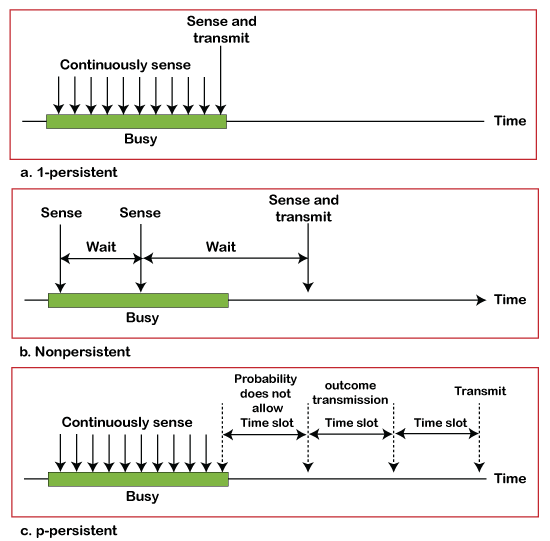
CSMA/ CD
It is a carrier sense multiple access/ collision detection network protocol to transmit data frames. The CSMA/CD protocol works with a medium access control layer. Therefore, it first senses the shared channel before broadcasting the frames, and if the channel is idle, it transmits a frame to check whether the transmission was successful. If the frame is successfully received, the station sends another frame. If any collision is detected in the CSMA/CD, the station sends a jam/ stop signal to the shared channel to terminate data transmission. After that, it waits for a random time before sending a frame to a channel.
CSMA/ CA
It is a carrier sense multiple access/collision avoidance network protocol for carrier transmission of data frames. It is a protocol that works with a medium access control layer. When a data frame is sent to a channel, it receives an acknowledgment to check whether the channel is clear. If the station receives only a single (own) acknowledgment, that means the data frame has been successfully transmitted to the receiver. But if it gets two signals (its own and one more in which the collision of frames), a collision of the frame occurs in the shared channel. Detects the collision of the frame when a sender receives an acknowledgment signal.
Following are the methods used in the CSMA/ CA to avoid the collision:
Interframe space: In this method, the station waits for the channel to become idle, and if it gets the channel is idle, it does not immediately send the data. Instead of this, it waits for some time, and this time period is called the Interframe space or IFS. However, the IFS time is often used to define the priority of the station.
Contention window: In the Contention window, the total time is divided into different slots. When the station/ sender is ready to transmit the data frame, it chooses a random slot number of slots as wait time. If the channel is still busy, it does not restart the entire process, except that it restarts the timer only to send data packets when the channel is inactive.
Acknowledgment: In the acknowledgment method, the sender station sends the data frame to the shared channel if the acknowledgment is not received ahead of time.
B. Controlled Access Protocol
It is a method of reducing data frame collision on a shared channel. In the controlled access method, each station interacts and decides to send a data frame by a particular station approved by all other stations. It means that a single station cannot send the data frames unless all other stations are not approved. It has three types of controlled access: Reservation, Polling, and Token Passing.
C. Channelization Protocols
It is a channelization protocol that allows the total usable bandwidth in a shared channel to be shared across multiple stations based on their time, distance and codes. It can access all the stations at the same time to send the data frames to the channel.
Following are the various methods to access the channel based on their time, distance and codes:
- FDMA (Frequency Division Multiple Access)
- TDMA (Time Division Multiple Access)
- CDMA (Code Division Multiple Access)
FDMA
It is a frequency division multiple access (FDMA) method used to divide the available bandwidth into equal bands so that multiple users can send data through a different frequency to the subchannel. Each station is reserved with a particular band to prevent the crosstalk between the channels and interferences of stations.
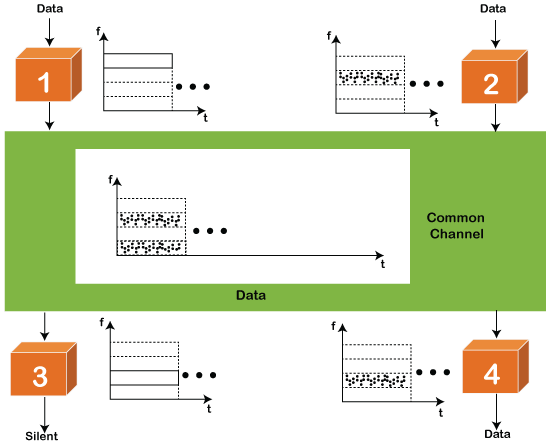
TDMA
Time Division Multiple Access (TDMA) is a channel access method. It allows the same frequency bandwidth to be shared across multiple stations. And to avoid collisions in the shared channel, it divides the channel into different frequency slots that allocate stations to transmit the data frames. The same frequency bandwidth into the shared channel by dividing the signal into various time slots to transmit it. However, TDMA has an overhead of synchronization that specifies each station's time slot by adding synchronization bits to each slot.
CDMA
The code division multiple access (CDMA) is a channel access method. In CDMA, all stations can simultaneously send the data over the same channel. It means that it allows each station to transmit the data frames with full frequency on the shared channel at all times. It does not require the division of bandwidth on a shared channel based on time slots. If multiple stations send data to a channel simultaneously, their data frames are separated by a unique code sequence. Each station has a different unique code for transmitting the data over a shared channel. For example, there are multiple users in a room that are continuously speaking. Data is received by the users if only two-person interact with each other using the same language. Similarly, in the network, if different stations communicate with each other simultaneously with different code language.
Key takeaways
- When a sender and receiver have a dedicated link to transmit data packets, the data link control is enough to handle the channel. Suppose there is no dedicated path to communicate or transfer the data between two devices. In that case, multiple stations access the channel and simultaneously transmits the data over the channel. It may create collision and cross talk. Hence, the multiple access protocol is required to reduce the collision and avoid crosstalk between the channels.
- For example, suppose that there is a classroom full of students. When a teacher asks a question, all the students (small channels) in the class start answering the question at the same time (transferring the data simultaneously). All the students respond at the same time due to which data is overlap or data lost. Therefore it is the responsibility of a teacher (multiple access protocol) to manage the students and make them one answer.
References:
1. Computer Networks, 8th Edition, Andrew S. Tanenbaum, Pearson New International Edition.
2. Internetworking with TCP/IP, Volume 1, 6th Edition Douglas Comer, Prentice Hall of India.
3. TCP/IP Illustrated, Volume 1, W. Richard Stevens, Addison-Wesley, United States of America.